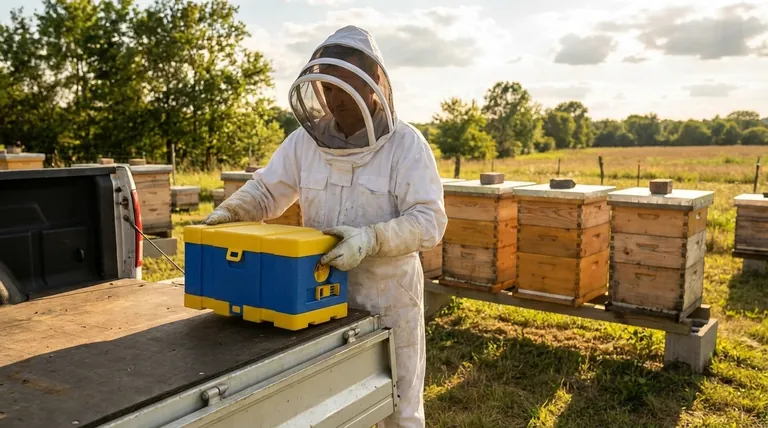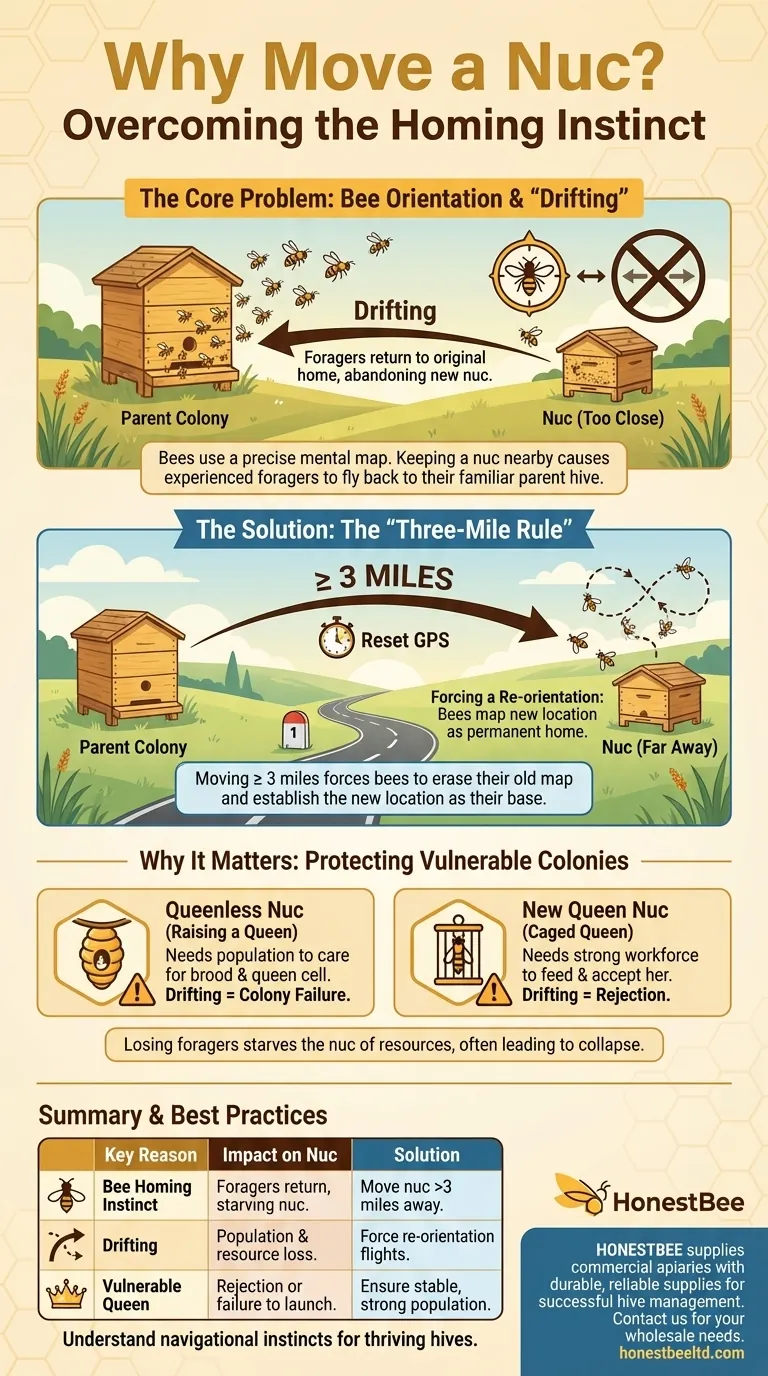Moving a nucleus hive, or nuc, is a critical management practice designed to prevent the colony's experienced forager bees from abandoning it. Because bees have a powerful homing instinct, they will return to their original parent hive if the new nuc is kept too close, causing the new, smaller colony to collapse from a lack of resources and population.
The core challenge is overcoming a bee's internal navigation. Moving a nuc at least three miles away forces the colony's foragers to reset their "GPS," compelling them to accept the nuc as their new permanent home and begin foraging from that location.

The Core Problem: Bee Orientation and "Drifting"
To understand why moving a nuc is necessary, you first have to understand how a honeybee sees its world. It's not about loyalty to a specific box; it's about a fixed location in space.
How Forager Bees Navigate
Foraging bees spend their first few flights meticulously mapping the landscape around their hive. They learn landmarks and the position of the sun to create a precise mental map.
This map allows them to efficiently return to the exact spot their hive occupies after foraging trips, which can be up to two or three miles away.
What is "Drifting"?
"Drifting" is the term beekeepers use to describe bees returning to their original hive location after being moved a short distance.
If you create a nuc and leave it in the same bee yard, its forager bees will leave the nuc for their first flight and simply fly back to the powerful, familiar parent colony they've always known.
The Impact on the New Nuc
A nuc is a small, vulnerable colony. It relies on its population of forager bees to bring in the nectar and pollen needed to feed the queen, nurse bees, and developing brood.
When these foragers drift back to the parent hive, the nuc is quickly starved of resources and its population plummets. This often leads to the failure of the nuc, as it can no longer sustain itself.
The "Three-Mile Rule" Explained
The solution to drifting is a simple but effective logistical one: move the hive beyond the bees' known world.
Why Three Miles?
The three-mile distance is a well-established rule of thumb in beekeeping. It is generally considered to be beyond the standard foraging and orientation range of a honeybee.
By placing the nuc in a completely new environment far from its original location, you effectively erase its old mental map.
Forcing a Re-orientation
When the bees emerge from their nuc in the new location, they immediately recognize that their surroundings are unfamiliar.
This triggers a new series of orientation flights. They will fly in circles and figure-eights in front of the nuc, re-mapping the new landscape and locking in the nuc's location as their new home base.
Common Scenarios and Their Trade-offs
While moving a nuc is always the best practice, it is especially critical in situations where the new colony is already under stress. Failing to move it has severe consequences.
The Vulnerability of Queenless Nucs
If you make a nuc that is queenless (with the intent for it to raise its own queen), losing your foraging workforce is often a death sentence.
The colony needs every bee to care for the developing brood and protect the vulnerable queen cell. Drifting robs it of the resources and population required for this critical task.
Supporting a New Queen
Similarly, a nuc given a caged queen needs a strong, stable population. The bees must feed her through the cage, chew the candy to release her, and immediately begin caring for her once she starts laying.
A dwindling population due to drifting can lead to the bees rejecting the new queen or the colony failing before she can establish a robust brood nest.
Making the Right Choice for Your Nuc
Your decision should be guided by the state of your new colony and your goal for its development.
- If your primary focus is creating a queenless split: You must move the nuc at least three miles away. This is non-negotiable for preserving the population needed to successfully raise a new queen.
- If your primary focus is introducing a new, caged queen: Moving the nuc is the only reliable way to ensure the colony is strong enough to accept, release, and support her.
- If your primary focus is simply dividing a colony: Moving the nuc remains the gold standard to prevent losing your field force and ensures the new colony gets the strongest possible start.
Understanding and respecting the navigational instincts of your bees is fundamental to helping them thrive.
Summary Table:
| Key Reason | Impact on Nuc | Solution |
|---|---|---|
| Bee Homing Instinct | Foragers return to parent hive, starving the nuc. | Move nuc >3 miles away. |
| Drifting | Nuc loses population and resources, leading to collapse. | Force re-orientation flights in a new location. |
| Vulnerable Queen | Weak colony may reject a new queen or fail to support her. | Ensure a stable, strong population in the new hive. |
Ensure your nucs get the strongest possible start. HONESTBEE supplies commercial apiaries and beekeeping equipment distributors with the durable, reliable supplies needed for successful hive management, including nuc transportation. Let our wholesale-focused expertise support your operation's growth. Contact our team today to discuss your equipment needs!
Visual Guide

Related Products
- 4 Frame Plastic Nuc Boxes for Beekeeping Bee Nuc Box
- HONESTBEE Professional Long Handled Hive Tool with Precision Cutting Blade
- Multi-Function Plier-Style Frame Grip Hive Tool
- Professional Multi-Function Stainless Steel Hive Tool
- Modern Flat-Mount Hive Number Set for Beekeeping
People Also Ask
- What are the benefits of maintaining a nuc in beekeeping? Gain Control and Resilience for Your Apiary
- What are nucleus colonies (nucs) and how do they compare to full-size Langstroth colonies?
- What should a healthy brood nest in a nuc look like? A Guide to Strong Colony Development
- What are the advantages of choosing a nucleus hive over a package of bees? Get a Head Start with a Pre-Established Colony
- How does colony growth differ between nucs and bee packages? A Guide to Faster Beehive Buildup



















